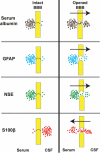A blood-brain barrier overview on structure, function, impairment, and biomarkers of integrity
- PMID: 33208141
- PMCID: PMC7672931
- DOI: 10.1186/s12987-020-00230-3
A blood-brain barrier overview on structure, function, impairment, and biomarkers of integrity
Abstract
The blood-brain barrier is playing a critical role in controlling the influx and efflux of biological substances essential for the brain's metabolic activity as well as neuronal function. Thus, the functional and structural integrity of the BBB is pivotal to maintain the homeostasis of the brain microenvironment. The different cells and structures contributing to developing this barrier are summarized along with the different functions that BBB plays at the brain-blood interface. We also explained the role of shear stress in maintaining BBB integrity. Furthermore, we elaborated on the clinical aspects that correlate between BBB disruption and different neurological and pathological conditions. Finally, we discussed several biomarkers that can help to assess the BBB permeability and integrity in-vitro or in-vivo and briefly explain their advantages and disadvantages.
Keywords: Blood–brain barrier; CNS; Degenerative; Disruption; Integrity; Markers; Neuroinflammation; Permeability; TEER; Tight junctions; Transcytosis.
Conflict of interest statement
The authors declare that they have no competing interests.
Figures




References
-
- Nag S, Begley D. Pathology and genetics cerebrovascular diseases. Basel: ISN Neuropath Press; 2005. Blood–brain barrier, exchange of metabolites and gases; pp. 22–29.
Publication types
MeSH terms
Substances
Grants and funding
LinkOut - more resources
Full Text Sources
Other Literature Sources
Medical

